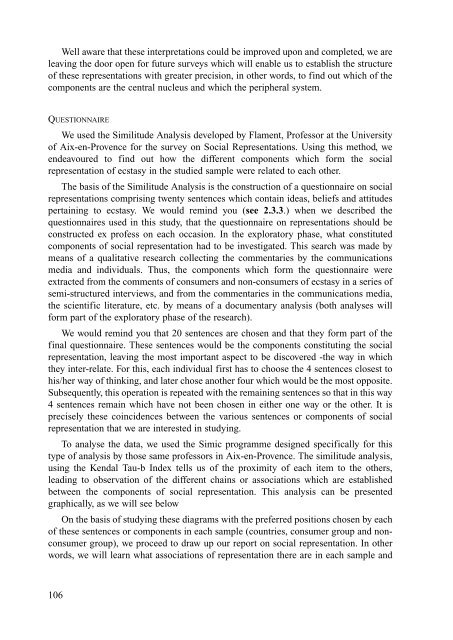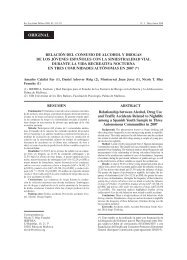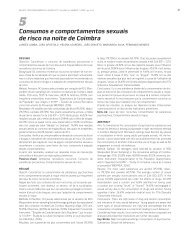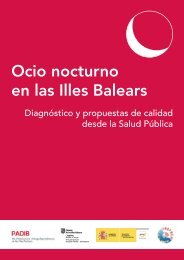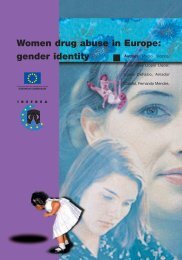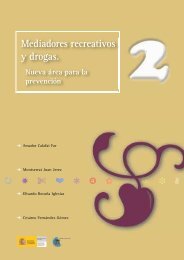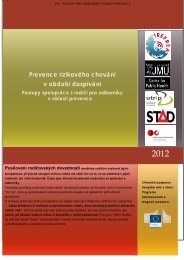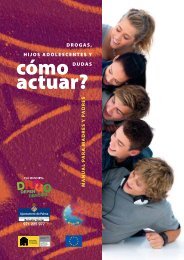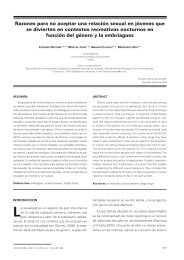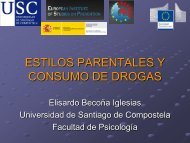Characteristics and social representation of ecstasy in Europe - Irefrea
Characteristics and social representation of ecstasy in Europe - Irefrea
Characteristics and social representation of ecstasy in Europe - Irefrea
You also want an ePaper? Increase the reach of your titles
YUMPU automatically turns print PDFs into web optimized ePapers that Google loves.
Well aware that these <strong>in</strong>terpretations could be improved upon <strong>and</strong> completed, we areleav<strong>in</strong>g the door open for future surveys which will enable us to establish the structure<strong>of</strong> these <strong>representation</strong>s with greater precision, <strong>in</strong> other words, to f<strong>in</strong>d out which <strong>of</strong> thecomponents are the central nucleus <strong>and</strong> which the peripheral system.QUESTIONNAIREWe used the Similitude Analysis developed by Flament, Pr<strong>of</strong>essor at the University<strong>of</strong> Aix-en-Provence for the survey on Social Representations. Us<strong>in</strong>g this method, weendeavoured to f<strong>in</strong>d out how the different components which form the <strong>social</strong><strong>representation</strong> <strong>of</strong> <strong>ecstasy</strong> <strong>in</strong> the studied sample were related to each other.The basis <strong>of</strong> the Similitude Analysis is the construction <strong>of</strong> a questionnaire on <strong>social</strong><strong>representation</strong>s compris<strong>in</strong>g twenty sentences which conta<strong>in</strong> ideas, beliefs <strong>and</strong> attitudesperta<strong>in</strong><strong>in</strong>g to <strong>ecstasy</strong>. We would rem<strong>in</strong>d you (see 2.3.3.) when we described thequestionnaires used <strong>in</strong> this study, that the questionnaire on <strong>representation</strong>s should beconstructed ex pr<strong>of</strong>ess on each occasion. In the exploratory phase, what constitutedcomponents <strong>of</strong> <strong>social</strong> <strong>representation</strong> had to be <strong>in</strong>vestigated. This search was made bymeans <strong>of</strong> a qualitative research collect<strong>in</strong>g the commentaries by the communicationsmedia <strong>and</strong> <strong>in</strong>dividuals. Thus, the components which form the questionnaire wereextracted from the comments <strong>of</strong> consumers <strong>and</strong> non-consumers <strong>of</strong> <strong>ecstasy</strong> <strong>in</strong> a series <strong>of</strong>semi-structured <strong>in</strong>terviews, <strong>and</strong> from the commentaries <strong>in</strong> the communications media,the scientific literature, etc. by means <strong>of</strong> a documentary analysis (both analyses willform part <strong>of</strong> the exploratory phase <strong>of</strong> the research).We would rem<strong>in</strong>d you that 20 sentences are chosen <strong>and</strong> that they form part <strong>of</strong> thef<strong>in</strong>al questionnaire. These sentences would be the components constitut<strong>in</strong>g the <strong>social</strong><strong>representation</strong>, leav<strong>in</strong>g the most important aspect to be discovered -the way <strong>in</strong> whichthey <strong>in</strong>ter-relate. For this, each <strong>in</strong>dividual first has to choose the 4 sentences closest tohis/her way <strong>of</strong> th<strong>in</strong>k<strong>in</strong>g, <strong>and</strong> later chose another four which would be the most opposite.Subsequently, this operation is repeated with the rema<strong>in</strong><strong>in</strong>g sentences so that <strong>in</strong> this way4 sentences rema<strong>in</strong> which have not been chosen <strong>in</strong> either one way or the other. It isprecisely these co<strong>in</strong>cidences between the various sentences or components <strong>of</strong> <strong>social</strong><strong>representation</strong> that we are <strong>in</strong>terested <strong>in</strong> study<strong>in</strong>g.To analyse the data, we used the Simic programme designed specifically for thistype <strong>of</strong> analysis by those same pr<strong>of</strong>essors <strong>in</strong> Aix-en-Provence. The similitude analysis,us<strong>in</strong>g the Kendal Tau-b Index tells us <strong>of</strong> the proximity <strong>of</strong> each item to the others,lead<strong>in</strong>g to observation <strong>of</strong> the different cha<strong>in</strong>s or associations which are establishedbetween the components <strong>of</strong> <strong>social</strong> <strong>representation</strong>. This analysis can be presentedgraphically, as we will see belowOn the basis <strong>of</strong> study<strong>in</strong>g these diagrams with the preferred positions chosen by each<strong>of</strong> these sentences or components <strong>in</strong> each sample (countries, consumer group <strong>and</strong> nonconsumergroup), we proceed to draw up our report on <strong>social</strong> <strong>representation</strong>. In otherwords, we will learn what associations <strong>of</strong> <strong>representation</strong> there are <strong>in</strong> each sample <strong>and</strong>106


